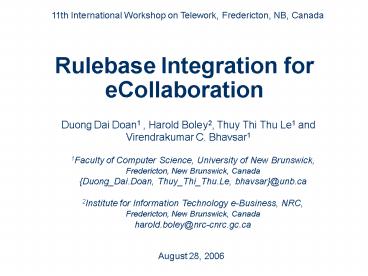Rulebase Integration for eCollaboration PowerPoint PPT Presentation
1 / 17
Title: Rulebase Integration for eCollaboration
1
Rulebase Integration for eCollaboration
11th International Workshop on Telework,
Fredericton, NB, Canada
- Duong Dai Doan1 , Harold Boley2, Thuy Thi Thu Le1
and Virendrakumar C. Bhavsar1
1Faculty of Computer Science, University of New
Brunswick,Fredericton, New Brunswick,
CanadaDuong_Dai.Doan, Thuy_Thi_Thu.Le,
bhavsar_at_unb.ca 2Institute for Information
Technology e-Business, NRC, Fredericton, New
Brunswick, Canada harold.boley_at_nrc-cnrc.gc.ca
August 28, 2006
2
Agenda
- Motivation
- Classification of Rulebase Integration Approaches
- Proposed Rulebase Integration Framework for
Interoperation and Interchange - Homomorphisms Semantics-Preserving
Transformations - Conclusion
3
Motivation
- Foundational work in semantic information
integration central to cluster of Semantic Web
projects at UNB and NRC Fredericton - eBusiness (Weighted-Tree Similarity Algorithm)
- eLearning (RuleML)
- eCollaboration (FOAF)
- Define the objects and vocabularies of
eCollaboration (e.g., merchandise, services) by
rules - Rules differ, syntactically, semantically, and
pragmatically, between (groups of) participants
of Web-based collaborations - Rulebase integration techniques needed
4
Motivation
- The goal of Semantic Web community
- Semantic information sharing and reuse
- Underlying many Semantic Web applications
- Rule-based systems
5
Previous work
- Integration of databases
- Well-studied and long-standing challenge in the
Database Community TSIMMIS, HERMES,LoPiX, HERA,
and MIX - A rule Head ? Body
- Head conclusion, Body condition
- When the body is empty, a rule is called a fact
discount(Customer, Product, "7.5 percent")-
premium(Customer),
regular(Product).
- (Relational) Database integration only deals with
such kind of facts - Database integration is regarded as special case
of Rulebase integration XSIS
6
Classification of Rulebase Integration
- Heterogeneous rulebases can be serialized in
different languages and use various fragments of
expressiveness - Classification is based on two main dimensions
- Language surface syntax
- Expressive(ness) fragment
7
Classification of Rulebase Integration
7
8
Integration of Rulebases Having the Same
Expressiveness
- Different rulebase providers have different
perspectives on a collaboration - Incoming rulebases are often heterogeneous
- Reconciliation conflicts between various
rulebases is the key issue of rulebase
integration - Conflicts are classified into four main types
(earlier slide)
9
Same Expressiveness - Synonyms
- Two terms (i.e., relations in rules) refer to the
same object synonyms
RB1 merchandise(X) - provider(Y,X),
warehouse(Y,Z). provider("Compact Corp.",
"Printer"). warehouse("Compact Corp.","Boston").
RB2 item(X) - supplier(Y,X), store(Y,Z). supplier
("Compact Corp.", "Printer"). store("Compact
Corp.", "Boston").
Solution term dictionary provided for
one-to-one transformation between relation names
10
Relation subsumption
- P and P are on the same path in a relation
subsumption hierarchy
Example P merchandise P product
subClassOf(merchandise, product)
subClassOf(P,P') is represented by P'(X) -
P(X). Example product(X) - merchandise(X).
11
Different Expressiveness
- Different rulebases can be formulated with
different levels of semantics
- Gain Datalog gt Horn logic Loss Horn
logic gt Datalog - More expressive rulebase can be split for maximum
interchange
12
(No Transcript)
13
Rulebase Interoperation vs. Interchange
- Rulebase interoperation performed on distributed
(autonomous) rulebases - Query transformation
- Distributed querying
- Answer composition
- Rulebase interchange
- Transforms heterogeneous rulebases into canonical
form - Using transformation rules, which themselves are
interchangeable - Information may be preserved or lost through the
transformation - This transformation can thus be total or partial
- Supports not only uniform querying but also
processing
14
Homomorphisms Semantics-Preserving
Transformations
- Transform a rulebase encoded in a language to
another language - Information is preserved during transformation
- Some information may be lost lossy
transformation
trans-1(infer(trans(XDD))) infer(XDD)
15
Conclusion
- Define the objects and vocabularies of
eCollaboration by rules (including taxonomies) - Classification of rulebase integration
- Resolution of conflicts
- Unified framework for rulebase integration
- Interoperation approaches
- Interchange approaches
- Homomorphisms for preserving inferential
semantics of rulebases on transformation - Rulebase interchange experiments with XSLT
stylesheets - XDD and RuleML 0.9
- RFML and (Functional) RuleML 0.91
16
Thanks !
17
References
- XML Schema Integration System (XSIS)
- http//people.unb.ca/b89ct
- RuleML homepage
- http//www.ruleml.org
- RuleML FOAF-A Use Case for Web-based Social
Networking - http//www.ruleml.org/usecases/foaf/
- AgentMatcher
- http//www.cs.unb.ca/agentmatcher/

